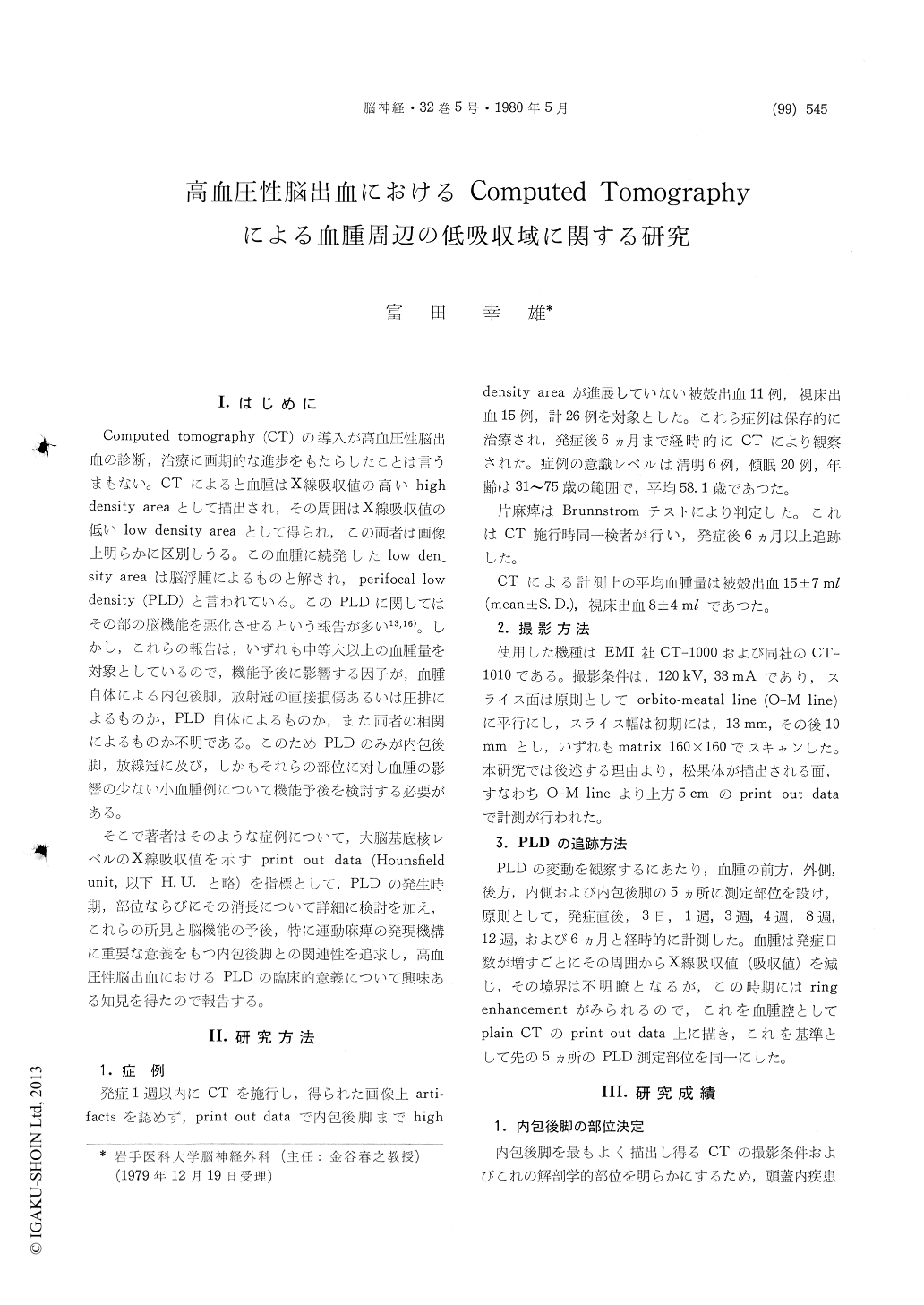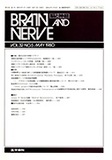Japanese
English
- 有料閲覧
- Abstract 文献概要
- 1ページ目 Look Inside
I.はじめに
Computed tomography (CT)の導入が高血圧性脳出血の診断,治療に画期的な進歩をもたらしたことは言うまもない。CTによると血腫はX線吸収値の高いhighdensity areaとして描出され,その周囲はX線吸収値の低いlow density areaとして得られ,この両者は画像上明らかに区別しうる。この血腫に続発したlow den_sity areaは脳浮腫によるものと解され,perifocal lowdensity (PLD)と言われている。このPLDに関してはその部の脳機能を悪化させるという報告が多い13,16)。しかし,これらの報告は,いずれも中等大以上の血腫量を対象としているので,機能予後に影響する因子が,血腫自体による内包後脚,放射冠の直接損傷あるいは圧排によるものか,PLD自体によるものか,また両者の相関によるものか不明である。このためPLDのみが内包後脚,放線冠に及び,しかもそれらの部位に対し血腫の影響の少ない小血腫例について機能予後を検討する必要がある。
そこで著者はそのような症例について,大脳基底核レベルのX線吸収値を示すprint out data (Hounsfield unit,以下H.U.と略)を指標として,PLDの発生時期,部位ならびにその消長について詳細に検討を加え,これらの所見と脳機能の予後,特に運動麻痺の発現機構に重要な意義をもつ内包後脚との関連性を追求し,高血圧性脳出血におけるPLDの臨床的意義について興味ある知見を得たので報告する。
The perifocal low density around hematoma (PLD) following hypertensive intracerebral hemor-rhage is well recognized on computerized tomo-graphy (CT). The author studied whether the PLD had a most demoralizing influence upon the functions in the brain in patients with small intra-cerebral hematoma. Twenty six patients were examined by means of serial CT scan to observe closely the fluctuation of the PLD. Out of 26 patients who were treated conservatively, 11 had putaminal hemorrhage and the remaining 15 had thalamic hemorrhage. The mean hematoma volume was 15±7 ml (mean±S.D.) in putaminal hemor-rhage and 8±4 ml in thalamic hemorrhage, re-spectively. The CT was performed with a head scanner, 160×160 martix system, and had a scanning time of one or four minutes. The picture of theslice at 5 cm above the orbitomeatal line on which the pineal body was clearly recognized was used in this study. The normal values of the attenuation coefficients at the internal capsule ranged from 24.1 to 33.6 Hounsfield units (H.U.) which was statistically determined by Smirnoff's rejection limits in 20 normal cases. So the attenuation coefficients of the low density component at the internal capsule was under 24.1 H.U.. In all patients, CT scan showed a low density lesion in the posterior limb of the internal capsule and did not define a high density lesions in the same place.
The results were analyzed in relation with the PLD and the motor disturbances in the follow-up study. The PLD around hematoma showed the lowest values on print-out data at one week after the ictus and the affected area returned to normal values at four weeks in both putaminal and thalamichemorrhage. On the other hand, the attenuation coefficients at the posterior limb of the internal capsule showed the lowest values later (at two weeks after the ictus) than the perifocal low density around hematoma, and they returned to the normal earlier. Motor disturbances were more marked immediately after the ictus and gradually recovered thereafter in the course, though the PLD developed to the internal capsule. These results were almost same in both putaminal and thalamic hemorrhage. These findings suggest that the motor disturbances of a pateint will recovere nearly completely in no distant future, if the only PLD develops agnainst the internal capsule on CT. Therefore, such a patient does not necessarily require the evaluation of hematoma.

Copyright © 1980, Igaku-Shoin Ltd. All rights reserved.


